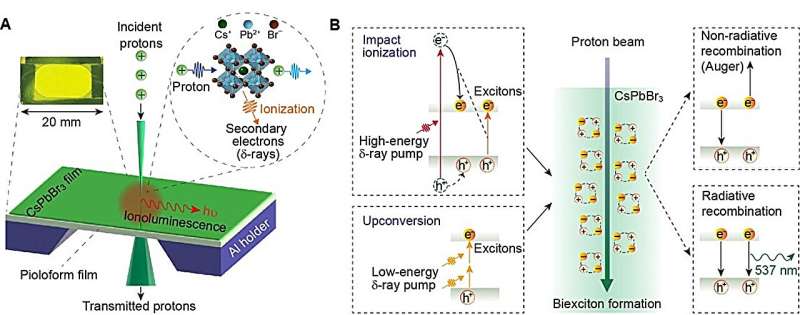This article has been reviewed according to Science X's editorial process and policies. Editors have highlighted the following attributes while ensuring the content's credibility:
fact-checked
trusted source
proofread
Single proton illuminates perovskite nanocrystal-based transmissive thin scintillators

National University of Singapore (NUS) researchers have developed a transmissive thin scintillator using perovskite nanocrystals, designed for real-time tracking and counting of single protons. The exceptional sensitivity is attributed to biexcitonic radiative emission generated through proton-induced upconversion and impact ionization.
The detection of energetic particles plays an important role in advancing science and technology in various fields, ranging from fundamental physics to quantum technology, deep space exploration and proton cancer therapy. The increasing demand for precise dose control in proton therapy has fueled extensive research into proton detectors. One promising approach to enable proton counting during radiotherapy involves the development of high-performance thin-film detectors that are transmissive to protons.
Despite advancements in silicon-based, chemical vapor deposition, diamond-based, and other types of proton detectors in recent years, a fundamental challenge remains unresolved: Achieving real-time proton irradiation with single-proton counting accuracy.
In single-proton detection, the detectable signal is fundamentally limited by the thickness of the detector. Therefore, a proton-transmissive detector must be fabricated at an ultrathin thickness while retaining sensitivity for single-proton detection.
Existing particle detectors, such as ionization chambers, silicon-based detectors and single-crystal scintillators, are too bulky to allow the transmission of protons. Additionally, organic plastic scintillators suffer from low scintillation yields and low particle radiation tolerances due to their low electron density, which hampers their single-proton detection sensitivity.
A research team led by Professor Liu Xiaogang from the Department of Chemistry and Associate Professor Andrew Bettiol from the Department of Physics, NUS demonstrated the real-time detection and counting of single protons using thin-film transmissive scintillators made of CsPbBr3 nanocrystals.
This approach offers unparalleled sensitivity with a light yield approximately double that of commercially available BC-400 plastic thin-film scintillators and 10 times greater than conventional bulk scintillators such as LYSO:Ce, BGO and YAG:Ce crystals. These results have been published in the journal Nature Materials.
The thin-film nanocrystal scintillators, with a thickness of approximately 5 µm, exhibit high sensitivity that allows for a detection limit of 7 protons per second. This sensitivity is about five orders of magnitude lower than clinically relevant counting rates, making it a significant advancement in single-proton detection technology.
The research team has put forward and substantiated a novel theory regarding the scintillation mechanisms induced by protons in CsPbBr3 nanocrystals. They have verified that proton-induced scintillation primarily arises from the population of the biexcitonic state in CsPbBr3 nanocrystals, facilitated by the process of proton-induced upconversion and impact ionization. This finding represents a significant contribution to the understanding of proton scintillation in perovskite nanocrystals.
By utilizing the enhanced sensitivity, together with the fast response (~336 ps) to proton beams and pronounced iono-stability (up to a fluence of 1014 protons per cm2), the researchers demonstrated additional applications of the CsPbBr3 nanocrystal scintillators. These include single-proton tracing, real-time patterned irradiation and super-resolution proton imaging.
Remarkably, their study has showcased a spatial resolution of sub-40 nm for proton imaging; this holds tremendous promise for advancing various fields, such as materials characterization, medical imaging and scientific research.
Prof Liu said, "The breakthrough presented in this work would be of considerable interest to particle radiation detection communities, offering both fundamental insights into new mechanisms of proton scintillation and technical advances in groundbreaking single-ion detection sensitivity using ultrathin proton-transmissive scintillators.
"In particular, these CsPbBr3 nanocrystal scintillators hold overwhelming promise for advancing detection technology in proton therapy and proton radiography."
More information: Zhaohong Mi et al, Real-time single-proton counting with transmissive perovskite nanocrystal scintillators, Nature Materials (2024). DOI: 10.1038/s41563-023-01782-z
Provided by National University of Singapore




















